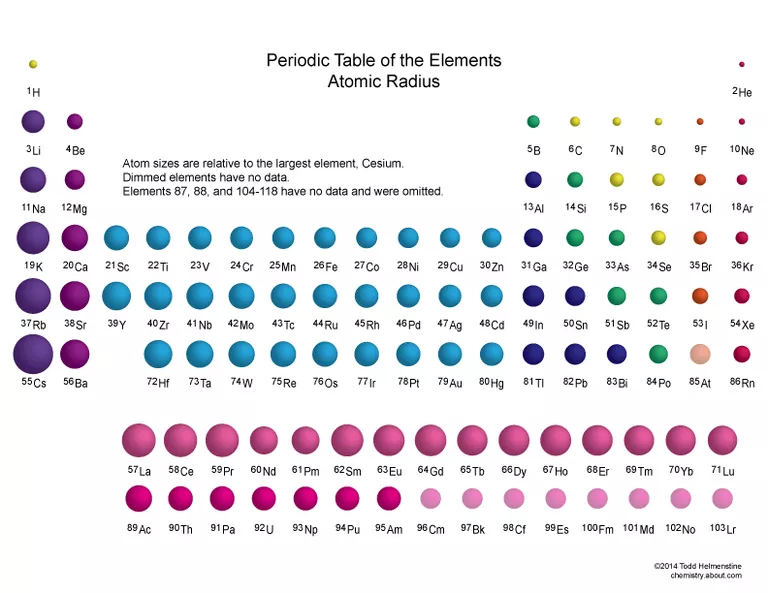Browse By Unit
Subject
🧪AP Chemistry
Study Guides by Unit
⚛️Unit 1 – Atomic Structure and Properties
🤓Unit 2 – Molecular and Ionic Bonding
🌀Unit 3 – Intermolecular Forces and Properties
🧪Unit 4 – Chemical Reactions
👟Unit 5 – Kinetics
🔥Unit 6 – Thermochemistry
⚖️Unit 7 – Equilibrium
🍊Unit 8 – Acids and Bases
🔋Unit 9 – Applications of Thermodynamics
What is the trend for atomic radius?
1 min read•july 11, 2024
Periodic Trends: The Atomic Radius
There are two things you should know about the periodic trend for atomic radius:
First, atomic radius increases as you go down the periodic table.
- The higher the period, the higher the energy level. Energy levels are represented by the coefficients when you write electron configurations (ex. the 1 in 1s², the 2 in 2p⁶, etc.).
- Electrons in the highest energy level are farthest away from the nucleus, so the size of the electron cloud increases going down the periods.
Second, atomic radius decreases from left to right across a period.
- This is because the effective nuclear charge increases with the addition of more protons.
- Effective nuclear charge is the net positive charge felt by valence electrons, estimated by (number of protons) - (inner electrons). In carbon, for example, the effective nuclear charge is +4 (6 protons minus 2 electrons in the first shell).
- In short, because you're adding protons, electrons feel a stronger attraction to the nucleus and the size of the atom decreases.

Check out these reviews for more help on periodic trends and the table of elements:
- Watch this 🎥 video on all of the periodic table trends
- For a quick review read this study guide on Unit 1: Atomic Structure and Properties
<< Hide Menu
What is the trend for atomic radius?
1 min read•july 11, 2024
Periodic Trends: The Atomic Radius
There are two things you should know about the periodic trend for atomic radius:
First, atomic radius increases as you go down the periodic table.
- The higher the period, the higher the energy level. Energy levels are represented by the coefficients when you write electron configurations (ex. the 1 in 1s², the 2 in 2p⁶, etc.).
- Electrons in the highest energy level are farthest away from the nucleus, so the size of the electron cloud increases going down the periods.
Second, atomic radius decreases from left to right across a period.
- This is because the effective nuclear charge increases with the addition of more protons.
- Effective nuclear charge is the net positive charge felt by valence electrons, estimated by (number of protons) - (inner electrons). In carbon, for example, the effective nuclear charge is +4 (6 protons minus 2 electrons in the first shell).
- In short, because you're adding protons, electrons feel a stronger attraction to the nucleus and the size of the atom decreases.

Check out these reviews for more help on periodic trends and the table of elements:
- Watch this 🎥 video on all of the periodic table trends
- For a quick review read this study guide on Unit 1: Atomic Structure and Properties

© 2025 Fiveable Inc. All rights reserved.